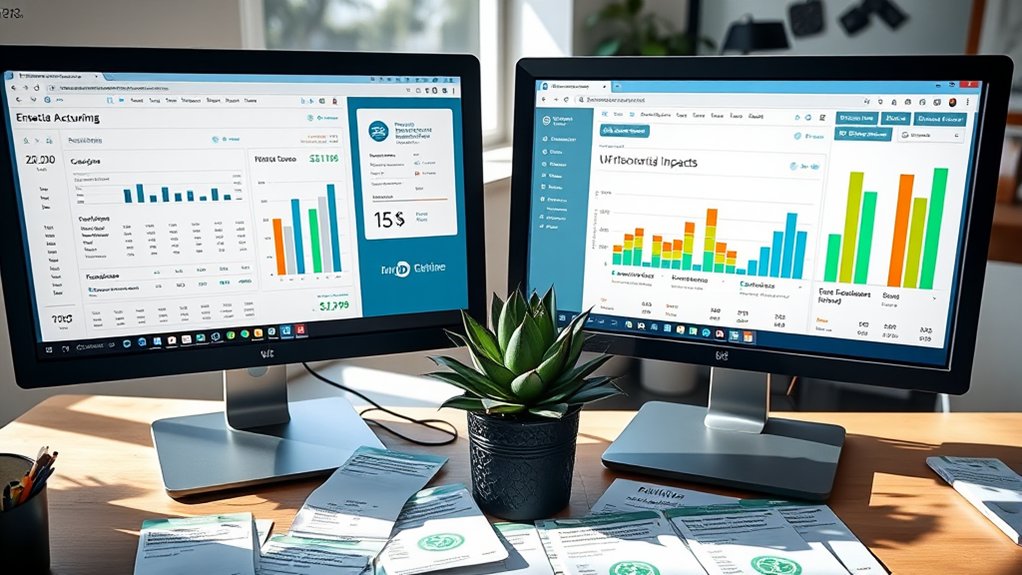Sustainable businesses face five major bookkeeping challenges that I’ve identified: integrating environmental metrics into financial records, managing certification documentation, tracking social impact investments, traversing carbon credit accounting, and implementing triple bottom line reporting solutions. To overcome these, I recommend adopting specialized sustainability accounting software, creating centralized digital repositories, implementing standardized measurement protocols, and utilizing AI-driven analytics dashboards. Understanding these core challenges will equip you with the foundation for effective sustainable business accounting.
Integrating Environmental Impact Metrics Into Financial Records

Three key challenges arise when integrating environmental impact metrics into traditional financial records. First, you’ll need to quantify intangible environmental costs like carbon emissions and resource depletion using standardized measurement protocols. Second, I recommend implementing dual-entry systems that track both financial transactions and their corresponding environmental impacts. Third, you must establish clear methodologies for monetizing environmental externalities to reflect true operational costs.
To overcome these obstacles, I’ve found that adopting specialized sustainability accounting software, engaging environmental auditors, and following GRI standards facilitates accurate integration of green metrics into your financial documentation.
Managing Complex Sustainability Certification Documentation
Building upon the environmental metrics tracking, sustainability certification documentation presents its own set of bookkeeping complexities. I’ve found that maintaining detailed records for multiple certifications requires a systematic approach to prevent documentation chaos. Let me show you how to master this challenge.
- Create a centralized digital repository for storing certification documents, audit reports, and compliance records
- Implement a certification renewal calendar with automated reminders to track deadlines and documentation requirements
- Develop standardized templates for each certification’s documentation requirements, ensuring consistency and efficiency
This structured approach will give you complete control over your certification processes while streamlining your bookkeeping workflows.
Tracking and Reporting Social Impact Investments

I’ve found that tracking social impact investments requires a dual focus on both financial returns and measurable social outcomes through specialized metrics and impact evaluation frameworks. As your sustainable business grows, you’ll need robust systems to monitor your social investment portfolio, including tools for measuring community benefits, environmental improvements, and governance impacts alongside traditional ROI calculations. I recommend implementing dedicated impact measurement software that can generate standardized reports for stakeholders while maintaining detailed records of both quantitative and qualitative performance indicators.
Measuring Impact Investment Returns
Impact investment returns present unique tracking challenges due to their dual nature of financial and social outcomes. I’ve found that properly measuring these returns requires sophisticated metrics and clear documentation systems to capture both quantitative and qualitative impacts.
To effectively measure impact investment returns, I recommend implementing:
- Standardized impact measurement frameworks like IRIS+ or GRI to quantify social outcomes
- Integrated reporting systems that combine financial performance with impact metrics
- Regular stakeholder feedback loops to validate social return calculations
I’ve learned that success lies in maintaining detailed records while avoiding the trap of overcomplicated measurement systems that can obscure true impact performance.
Social Investment Portfolio Management
Once impact measurements are established, effective portfolio management becomes the next key challenge. I recommend implementing a dual-tracking system that monitors both financial and social returns simultaneously. You’ll need specialized software that can aggregate ESG metrics alongside traditional performance indicators.
I’ve found that successful social investment portfolios require meticulous documentation of impact outcomes, particularly for regulatory compliance and stakeholder reporting. This means tracking key performance indicators like carbon reduction, job creation, and community benefit metrics. You must also maintain detailed records of impact verification methods and third-party assessments to validate your social return claims.
Navigating Carbon Credit Accounting and Offsets
I’ll help you understand the complexities of carbon credit valuation through two primary methods: market-based pricing and cost-based calculations. When accounting for carbon offsets, you’ll need to maintain detailed verification documentation that includes third-party certifications, project specifications, and retirement confirmations. I recommend implementing a dedicated ledger system to track both purchased and generated carbon credits, ensuring accurate financial reporting and regulatory compliance.
Carbon Credit Valuation Methods
The complex landscape of carbon credit valuation requires specific methodologies to accurately assess and record offset values in sustainable business accounting. I’ve identified three critical valuation methods you’ll need to master:
- Market-Based Pricing: I determine credit values through live trading exchanges and verified broker transactions, giving you real-time market insights
- Cost-Based Approach: I calculate values based on project implementation expenses, including verification and monitoring costs
- Social Cost of Carbon: I incorporate government-established carbon prices that reflect long-term environmental impact
You’ll gain a competitive edge by implementing these methods while ensuring compliance with emerging carbon accounting standards.
Offset Verification Documentation
Since proper documentation forms the backbone of carbon credit verification, maintaining detailed records across your offset projects requires meticulous attention to detail. I recommend implementing a three-tier documentation system: baseline emissions data, reduction measurements, and third-party verification reports.
You’ll need to archive emissions reduction purchase agreements (ERPAs), monitoring reports, and validation statements. I’ve found that organizing these documents in a centralized digital repository with version control guarantees audit readiness. Track your methodologies, calculations, and assumptions meticulously – regulators will scrutinize these. Store your raw data separately from processed results to maintain data integrity and traceability.
Implementing Digital Solutions for Triple Bottom Line Reporting

Modern digital solutions have revolutionized triple bottom line (TBL) reporting by streamlining data collection, analysis, and presentation across environmental, social, and financial metrics.
I recommend implementing these powerful digital tools to transform your TBL reporting:
- Cloud-based accounting platforms that integrate real-time sustainability metrics with financial data
- Automated data validation systems that guarantee compliance with ESG reporting standards
- AI-driven analytics dashboards that convert complex sustainability data into actionable insights
Balancing Traditional and Sustainability-focused Financial Controls
While traditional financial controls focus primarily on monetary performance, sustainable businesses must develop integrated control systems that monitor both conventional accounting metrics and sustainability key performance indicators (KPIs). I recommend implementing dual-track monitoring systems that align financial outcomes with environmental and social impacts. You’ll need to establish clear metrics for carbon footprint, resource consumption, and social responsibility alongside standard profit margins and cash flow metrics. I’ve found that successful integration requires automated data collection tools and standardized reporting templates that capture both financial and sustainability data in real-time, enabling swift decision-making and stakeholder accountability.









